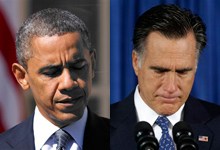In times of international tension and crisis, photographic imagery and setting are critically important. The backgrounds that elected officials and candidates choose send strong signals that may be as important as what the candidate is saying.
Wednesday morning, Republican Presidential nominee Mitt Romney planned to make a campaign speech before 150 supporters in Jacksonville, Florida. But moments before he was to start speaking, the campaign hustled supporters out of the room and moved journalists to another setup for Romney’s appearance. CNN showed the campaign workers quickly planting four American flags in front of a navy blue screen behind a lectern where Romney would speak.
Romney came out moments later and delivered a strongly worded critique of the Obama Administration’s response to the attacks on the U.S. Embassy in Libya and the death of U.S. Ambassador Christopher Stevens and three staffers there.
Think about what a different signal the comments would have sent if they had been interrupted by cheering supporters. Romney is already being criticized for politicizing the attacks; a crowd would have added fuel to the critiques. The blue background and flag made him appear presidential.
A short time later, President Barack Obama appeared in the White House Rose Garden. The lighting was harsh, the president stood in front of the doors to the Oval Office.
Consider for a moment how the President’s remarks would be different if he was sitting behind the desk of the Oval Office. Think of the stark seriousness of the setting he chose the night that he announced that Osama bin Laden was dead. Standing in the Rose Garden sends a less ominous signal: “This is serious,” it says, “but we are not overwhelmed by it.” In fact, the president will move on to fly to Las Vegas for a campaign trip today.
The candidates’ attention to backgrounds and settings can teach journalists a lot. When you interview a subject, consider how the setting will influence what they say or how they act. Consider how the background and lighting will affect the way viewers interpret the context of the interview.
The graphic images
The images that journalists use to tell the story of the Embassy deaths could influence public opinion about how much or any force will be used in response. Singular images can sometimes define how Americans respond.
Especially this week, a week when emotions are rubbed raw once again by 9/11 commemorations, any cold-blooded attack on any American can ignite extreme responses.
Why then, if it was newsworthy to show the bloodied body of Moammar Gadhafi on the news, and it was widely shown, why would journalists make any other decision about using the graphic images that are surfacing of the moments after the ambassador’s death, surrounded by a crowd?
Gadhafi was a world leader, a terrorist who was being hunted down in a civil war. His death was of global significance, like the deaths of bin Laden and Saddam Hussein. The images of their deaths were proof that an era had ended. The brutality of Gadhafi’s death, the images of him hiding in a drainage pipe, were part of the manhunt story that unfolded.
Stevens, on the other hand, is a name you likely did not know until today. There may be reasons to show the images. For example, using the images of his last moments may be newsworthy because they add credibility to Secretary of State Hillary Clinton’s statement that Libyan citizens carried Stevens’ body to the hospital. That could be a telling and important detail, as opposed to the killing mob around Gadhafi.
The images that we see, whether it is grim-faced candidates, flag burning protestors, or Libyan civilians attempting to help a dying ambassador, will become key ways that we understand this story.
Three reminders about photography
Keep images in context. Closeup photos give details but wide shots show context. Both are components of truth. Remember, the public just re-lived 9/11. See the story through the lens of the week, not the lens of minute-to-minute news coverage.
Tone and degree is critical. How prominently are you playing the most graphic images? How often do you repeatedly use the most graphic images online, on the air or in print? If you use graphic images, forewarn the public. Screaming headlines and promotions can undermine thoughtful, serious coverage.
Weigh the public’s need to know. Sometimes it is the job of the journalist to show the public disturbing images or share unsettling news. You should be informed by what you anticipate the public’s reaction will be to your choices but you should be guided by journalistic principles. Explain your decisions to the public.
Here are links to the graphic images referred to in the story:











Comments